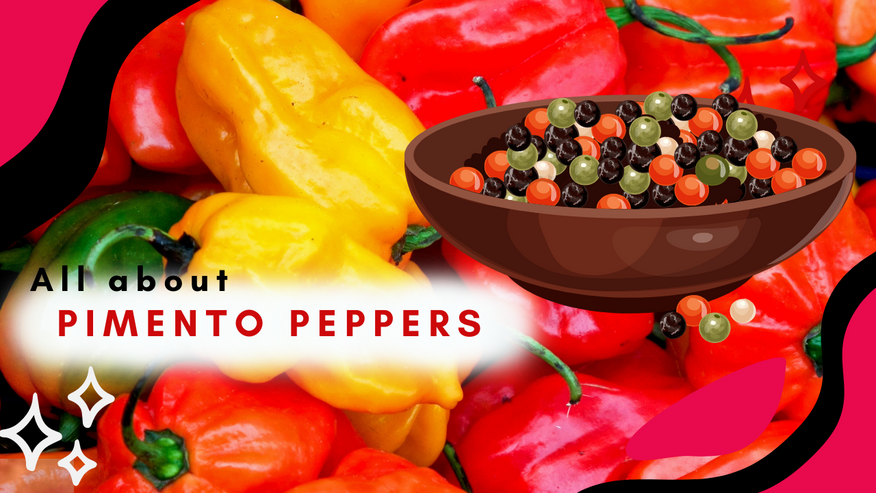Feb 9th 2023 - Team
What is a Pimento? Origins, Recipes, and More!
Small, heart-shaped, mild, sweet peppers called pimiento peppers are used to stuff olives and make the famous pimiento cheese. Discover pimentos' history and why they're so popular in Southern cuisine and cheese.
So, what is pimento then?
 Also known as cherry peppers, pimentos are more than just the red pepper center of an olive; they're also distinct pepper. It has a low Scoville rating (between 100 and 500 heat units), making it one of the least spicy peppers. Pimientos are commonly referred to as cherry peppers due to their diminutive size and mild sweetness.
Also known as cherry peppers, pimentos are more than just the red pepper center of an olive; they're also distinct pepper. It has a low Scoville rating (between 100 and 500 heat units), making it one of the least spicy peppers. Pimientos are commonly referred to as cherry peppers due to their diminutive size and mild sweetness.
The flavor of a Pimento Pepper
Peppers from the pimento plant are not so spicy. They are one of the mildest peppers, sweet, and succulent. It is common to eat them pickled, but they are also delicious when eaten straight from the garden. You can use them like red bell peppers in dishes.
Santa Fe Grande and Floral Gem are two examples of spicy cultivars. They're a nice size for stuffing and work well when dehydrated and ground into chili powder.
Paprika, a popular seasoning, is actually ground-up and dried pimento peppers. They are also mixed with other types of mild or sweet peppers.
How Hot Is It?

On the Scoville Scale, a pimento pepper registers between 500 and 1,000 Scoville Units, making it one of the least spicy peppers available. If you're used to the heat of jalapeno peppers, which typically range from 2,500 to 8,000 Scoville Heat Units, you would definitely handle even the hottest pimento.
The Piquillo Pepper, which is slightly different in shape but otherwise quite similar, is a good reference for gauging these two peppers' relative spiciness and flavor.
History and Origin

What we call a "pimento" or "pimiento" in English has a fascinating etymology. The noun "pimento" has evolved over time. Presently, its meaning differs in English, Spanish, and Portuguese.
Both the Spanish and Portuguese words for "pimento" (a spice) come from the Latin pigmentum (a coloring agent). Due to the gradual expansion of their meanings over time, speakers of these Iberian languages now use "pimento" and "pimiento" interchangeably to refer to any kind of pepper variety.
In English, today's use of the word "pimento" would likely baffle a 19th-century American cook. In the past, the term "pimento" referred to the unripe berries of the Pimenta dioica plant, which are now used to make allspice. It wasn't until the 1880s and 1890s that recipes mentioning "sweet Spanish peppers," that it became popular. Large-scale producers started bringing in and selling this variety of pepper, called "pimiento" in Spanish, around that time. The new meaning using Portuguese spelling began to gain popularity at the turn of the twentieth century. A single pepper became synonymous with the Spanish word for all peppers sometime during the Atlantic crossing.
Recipes with Pimento That You Need to Try
Stuffing, pickling, drying, and regular cooking are just a few of the many uses for pimento peppers; however, they can also be used to great effect in sauces. There are many popular or even comfort, common recipes that feature pimento peppers, such as stuffed peppers and pickled peppers, but the one that has gained the most notoriety is the southern pimento cheese.

Give these sauces or dip recipes a try with your freshly harvested pimentos:
- Peperonata
- Ajvar
- Sweet Roasted Red Pepper Sauce
- Pimento Cheese
- Muhammara (Roasted Red Pimiento Pepper and Walnut Dip)
- Romesco Sauce
"Olives packed with Pimientos"

Stuffing olives with pimento is a culinary custom that likely originated in the Provence region of France in the 18th century, however pinpointing the exact origin of culinary traditions is often difficult. The salty, briny, bitter flavor of olive can be overpowering, so it's important to balance it with something mellow and sweet.
While the custom has lasted, up until about the last 50 years, it took a lot of manual labor to stuff a pimento into an olive. Automatic olive-stuffing machinery was not invented until 1962 when a business headquartered in Seville, Spain named Sadrym was able to perfect their design.
Pimento is typically seen diced or mashed these days because of the need for more effective personnel practices in olive. The procedure is drilling an exit hole, forcing the pit out the other end, and injecting some of the pimento mixtures into the resulting void.
Is There Anything That Can Be Used Instead of Pimento Peppers?

It is dependent on the intended purpose and the type of scrumptious recipe you want to cook up. If you can't get pickled pimentos, use any other kind of sweet pickled pepper instead. Peppers of any color can be pickled, although red ones are best. In a pinch, try pickling your own peppers.
Bell peppers are a good stand-in if you can't find fresh pimentos. You can also use any sweet red pepper species, such as the piquillo pepper, corno di toro pepper, or any Italian sweet pepper.

